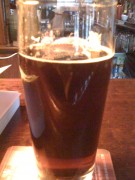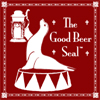Chuck Duffney of dieseldrafts.com is a talented brewer and frequent guest on Beer Sessions Radio. After a taping one night, Chuck pulled out a growler of a brown ale and set it on the table at Roberta’s Restaurant. As we kicked back a few glasses, Chuck told us the story of his tasty brew called Liberty Bell and how it came to be. The table agreed, the beer was delicious and the story well worth passing on. Without further ado, here is the Liberty Bell’s true story

Liberty Bell- American Brown Ale’s Different Leanings
by Chuck Duffney
Rock & Roll, Comedy, Brown Ale. The Brits often get there first, but America makes things taste better. For me brewing is about people, bringing people together and getting to know others. I like to brew beer that the drinker is going to enjoy, not just what I want to have, and doing that spurs a dialog with my friends and I come to understand their tastes better. There is a beer for everyone, even those that don’t drink alcohol. This story is about how one recipe reacted to life’s ever-changing demands and morphed 3 times to be the beer the drinker wanted.
Examples of American Brown Ale can vary in their flavor profile. Roast or chocolate notes should always be present. While the balance may lean towards more caramel tones and residual sweetness, other beers will be more bitter with hop aromas as a focus. American Brown Ales showcase American hops, not to the degree of the Pale Ales of this land, but citrus hops are moderately used for flavor and aroma. Always the beer is brown, not amber or black. The key with brown ales is balance, there are many flavors but each is present only in moderate to low levels.
Through slight changes in the recipe and process, a brewer can lean the balance of the beer in different directions to highlight desired flavors. A couple years ago I was brewing a beer for my buddy’s birthday; Tom said to me that he wanted a brown ale with a clear roast character, a strong American hop bouquet that wasn’t Cascades and a little kick in the pants with the ABV. He also made it clear that he did not want it to be sweet, no residual sweetness.
For his brew I chose two of my favorite hops varieties, Centennial and Amarillo. I upped the charges at 15 and 5 minutes left in the boil to increase the taste and aroma. Roasted malt is essential for getting the roast and chocolate flavors in the beer, and also add color, but for balance I avoid the malts over 400 SRM. Caramel malts are also needed to give the caramel or toffee notes, however my friend wanted a drier beer so I used just a little bit of Caramel 60 for color and body. More importantly, a key process control to produce the dry finish my friend requested was keeping the mash temperature low. This produced a more fermentable wort which I fed to a yeast known for fermenting clean and completely, reducing most of the sugar to alcohol.
The beer satisfied Tom’s craving, and we named it Liberty Bell. Though the beer was brewed for his birthday, I was able to get it on tap just 10 days after brewday for my Super Bowl party. At around 6% ABV the beer could get a party going. This was my first time brewing for Tom and I hit all the main points he desired. It helped that he had some understanding of beer flavor and was able to accurately describe what he wanted. We drank the beer over several weeks and noticed how the flavors would mellow and the beer would become more drinkable. At some point however the flavors he wanted became too subdued. This became a major point of discussion for the next batch.
Tom married his lovely wife about 6 months later. For their wedding I brewed 6 different beers, and Liberty Bell was his top choice. It was the largest event for which I had ever brewed, and the largest amount of my beer ever being served at once. What’s more it was the first time I wouldn’t be able to directly represent my beer, the caterers would be pouring. There was much to discuss to prepare for such an important occasion, but this recipe received special attention.
My initial reaction to the beer on Super Bowl Sunday was that the roast character was too assertive. I thought that perhaps I had dried out the beer too much. Yet this was to Tom’s taste, he loved having the roast right in his face. After a couple weeks the aggressive roast gave way to a delicious dark chocolate character. Hop aroma was still strong and we knew the beer had hit its prime. Drinking the beer over the course of several weeks let us plan the proper fermentation schedule for the wedding rendition of Liberty Bell. It was important to use the same yeast strain to take advantage of this knowledge and have the beer at its prime on the big day.
Eventually the hop aromas diminished. Yet I kept the hopping schedule the same because this brew was for an event on a single day so there wasn’t a need to increase the hops. As this brew was for a large party we decided to back off a touch on the ABV. This was achieved by slightly reducing the amount of base malt used. The other malts remained unchanged to keep their relative balance the same.
This batch produced the beer Tom wanted that day, and was well received by most people at the wedding. Not everyone wants these flavors in their beers so there were lighter brews available for others. Liberty Bell was there for Tom and our discussions over many pints for the weeks around his birthday led to the right beer for him. Just a few days after the wedding I left for Chicago to study at Siebel Institute.
Going through the World Brewing Academy program was an invaluable experience. The knowledge gained in such an intensive program is enormous, but the people you meet change your life. Industry connections were formed, and close friendships solidified over man’s greatest drink. During our time in München I made friends with many locals. One blue-eyed Bavarian named Belle caught my attention and inspired the latest interpretation of Liberty Bell.
Belle was coming to America and I was trying to learn her tastes for beer over the phone. During the WBA program you are always drinking with other trained palates, people educated in beer flavor identification. When a friend lacks the background to accurately describe the desired flavors, I have conversations about other beers they have tried and also other foods that they like.
Helles, Belle told me, was too bitter for her taste. Helles is known to be the sweetest of the light lagers, but that doesn’t invalidate her reaction to the beer. I needed to find something to which she has had a positive reaction. Talking about other beers I knew she had tried, I found she liked Weiss more which lacked the crispness of a lager and had a fuller body. In her words it wasn’t as bitter.
I wanted more information about her tastes before deciding on Liberty Bell. I knew Belle liked chocolate, what woman doesn’t, and so I asked her about the kinds of chocolate she preferred. Upon discovering she enjoyed the dark bitter chocolate more than milk, I realized it wasn’t bitterness exactly that she disliked in Helles but how that flavor was created and what was balancing it. The roasty chocolate provided a pleasing bitterness to her palate. So the most recent Liberty Bell was modified to be a sweeter beer, with residual sweetness, but the base ingredients remained the same.
To slant the balance from the assertively dry and roasty finish of Tom’s birthday beer to a sweet and malty beer for Belle’s taste 4 changes were made. First the mash temperature was elevated, leaving more of the starches reduced only to unfermentable sugars, which are later broken down by enzymes in saliva creating residual sweetness. Next I increased the amount of Caramel malt to provide more caramel and toffee flavors. Hops were to be understated, so I reduced the 15 and 5 minute additions but kept the bittering additions the same. Finally I used a different yeast strain, one known for being less attenuative and providing a fuller beer.
I shared this beer with Belle when she was in New York several weeks ago, and then again after 3 weeks on the road. When it was fresh, American hop aroma was the dominant aroma to my nose, but the beer was markedly sweeter while still presenting the dark chocolate flavors. A month later the hop aroma had dwindled, I picked up roast as the dominant aroma and the beer seems balanced a touch sweeter because of it. She enjoyed the beer initially, and I think now it may suit her palate even more.
Liberty Bell has rung differently the past three times it has struck. Each time it has suited the person who inspired the brew. The recipe has changed with my relationships, and has been a way to learn more about my friends. I hope this story can help others learn how brewers work with ingredients and processes to create the desired balance of flavors in the finished beer.
Na zdrowie!
